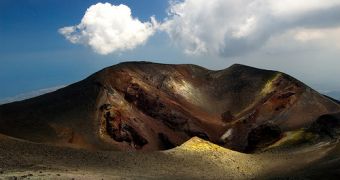Over the years, there have been many explanations for Mount Etna and the surrounding volcanics, but the dynamic model developed by renowned geophysicist Dr Wouter Schellart, at Monash University, is the first to explain the timing, origin and dynamics of the activity.
Mount Etna is one of the most fascinating volcanoes in Europe, but also one of the greatest volcanic mysteries.
“Most volcanism on Earth occurs at plate boundaries in places where tectonic plates move apart (e.g. Iceland) and in places where tectonic plates come together with one plate diving (subducting) below the other plate into the mantle (e.g. Pacific ring of fire),” said Dr Schellart.
“For the latter scenario, the volcanoes form directly above the subducted plate.”
Dr Schellart used fluid dynamic models in order to provide another explanation for the existence of Mount Etna, its geological environment and evolution, as well as volcanism in the surrounding region.
He suggests that this volcano is not the results of tectonic plate boundary activity, but rather it results from the decompression melting of the upper mantle matter flowing close to the Ionian slab, which is slowly sinking into the Earth's mantle.
“The chemistry of the volcanic rocks from Mount Etna and the nearby Iblean volcanics in Sicily and in the surrounding seas indicate that they are intraplate volcanics,” said the geophysicist.
He explained that intraplate volcanism is a type of volcanism that occurs far from plate boundaries and whose origins are rather controversial.
“Interestingly, the volcanics are located within a few hundred kilometers of, but are laterally offset from, the Calabrian subduction zone plate boundary, where the African plate sinks below the Eurasian plate,” he added.
“This suggests that the volcanics are somehow related to the Calabrian subduction zone [and] new modeling of subduction and mantle flow confirms this, showing that backward sinking of the African plate at the Calabrian subduction zone induced flow around the southern edge of the subducted plate and upward below Sicily.
Dr Schellart explained that “the upward flow induced decompression melting of upper mantle material and these melts extruded at the surface in Sicily, forming Mount Etna and the Iblean volcanics.”
Mount Etna is one of the most active volcanoes in the world, being almost in a continuous state of activity.
The latest ash explosion happened in August and it caused an ash plume that rose 800 meters above the crater edge.
This new research was published in the journal Geology.

 14 DAY TRIAL //
14 DAY TRIAL //